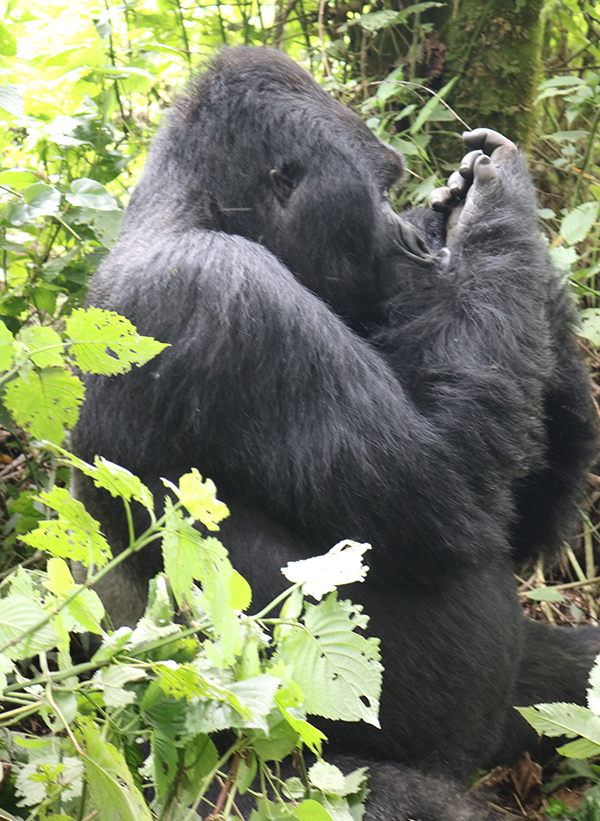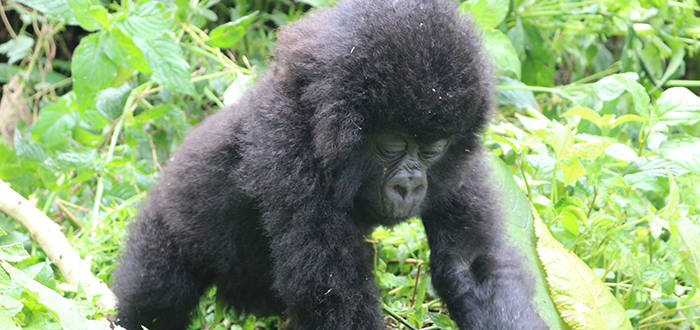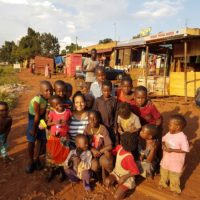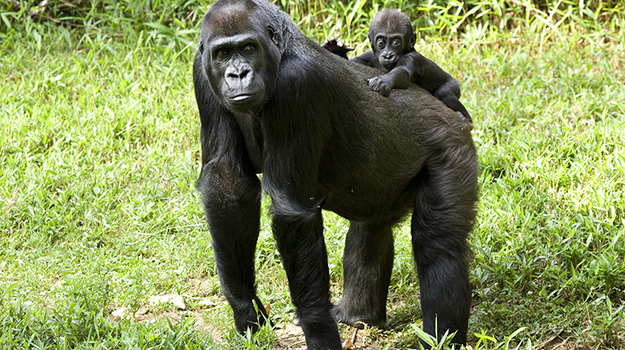My going to DRC was the result of extensive google research on cost of gorilla tracking! Well, the idea of tracking gorillas had been playing on my mind, but the cost – well, that is another story. To cut it short, gorilla permits in Rwanda and Uganda (the two other countries where you can actually track the apes) was, to say the least, horrendously expensive. The poorer neighbor, DRC came up the winner on my list. The cost of tracking gorillas in Congo was nearly one third the price – so all was set.
Till I ran into the logistic issues. Well, the capital of Congo, Kinshasa is on the west side of Africa, and Goma, the home of the gorillas was on the east. Congo isn’t exactly a small country, it is the second largest in Africa, and there was no sense in flying to the capital and backtracking to Goma! The only option open to me was to fly into Kigali, Rwanda’s capital and drive three hours to reach Goma, just across the border with Rwanda.

And that is how I arrived in Goma to tick off a wish on the long list of wishes I have made up for the rest of my life! Enough of reading Dian Fossey’s memoir (Gorillas In The Mist) or watching King Kong – I wanted to see the real thing. Despite the staggering costs, I was glad to be finally here.
Two things happened as soon as I arrived. I began to rain, accompanied by hail storm and lightening, the kind I have never seen before. Secondly, there were rumours that the volcano, Nyiragongo was showing signs of activity. Given that the volcano had erupted in 2002 and caused terrible damage to the city of Goma and its people, there was uneasy feeling everywhere. While some shrugged it off as “something to be endured”, others were particularly wary that if that did happen, the chances were that the magma from the volcano could reach Lake Kivu and that could mean a certain disaster.
The reason I bring this up is because, my hotel, the lovely Hotel Caritas, was right on Lake Kivu. So you can imagine my worry. So the first night of my stay in Goma, I drowned my fear in some fine local beer – Primus and Muetzig, bottled somewhere along the lake on Rwandan side, accompanied with deep fried fish named sambaza.
Now, this tiny fish is no bigger than a finger, is found in Lake Kivu and is very delicious. My mind went back to the Hamsi fish I had loved in Turkey, the deep fried sardines found in toddy shops in Kerala – but the winner was sambaza!
Hotels in Goma are few and the options of outdoor activity are nil, so after dark, all the hotel guests converge in the bar by the lake to watch the light fade over the lake. It helps when there are other guests sharing travel stories and how they came to be in Goma, and soon enough the evening becomes one big party where beer flows endlessly and sambaza arrives fresh and crackling and the thought of the exploding lake becomes a distant memory.
Day 2. The morning is another story.
Breakfast is laid out early – for those tracking gorillas leave as early as 6.30am. I thoughtfully packed boiled eggs and bananas for the long ride into the mountains. I knew there was no chance of finding a restaurant anywhere and seeing the apes involved few hours of walking in thick forests. I hate to be hungry at any given time. We crossed the town of Goma in matter of minutes – a smallish town in the shadows of the volcano, Goma is the hotspot of UN and UNHCR and NGO’s – and it is not uncommon to see western expats rubbing shoulder with locals, so early in the morning.

I am not sure if it was a good idea to have eaten so much food so early, because when the journey began, it was mostly over dirt roads with giant craters filled with water and constant rattling over bumpy roads, that I soon began to regret. But as a seasoned traveler will, that too was taken in the right spirit of adventure. We drove past the smoking volcano, looking calm in the early morning light – little does the world know about the damage it cause and what it was capable of, if it decided to explode. I shuddered at the thought.
Minus the uneasy feeling, thanks to the bone rattling drive, it was beautiful. Each passing mile meant going deeper into the countryside. No more the jean-clad youngsters here – this was real Congo. A country blessed with fertile land and rain. Women with babies bent over potato farms, young men hustling cows and goat, small decrepit villages sprung out of a forest and in the middle of it all – their only and preferred mode of transport – the TVS bikes!
TVS bikes run as public transport – called moto (boda boda in Uganda) and is the easiest, fastest and the cheapest way to get from one point to the other. Even if there are no pieces of road to drive on, the moto will find a way! Thus, it becomes the carrier of people, livestock and agriculture produce.

Two hours later, I pull up at the gates of Virunga National Park. It is nothing but a few rooms bunched together and few visitors.
But when you look around, you realise how serious they are about conservation of their gorillas. Armes rangers are everywhere, and the officials of the Virunga National Park put in a lot of effort to keep miscreants and poachers away.
Along with few other visitors, I was given the pre-tracking briefing, before which we were enlightened about the gorilla families (yes, gorillas live as families, just like us humans). There were eight families that were accessible to visitors, but of course, in each trip (such as the one I was on), the visitors got to see one family at close quarters. Each family usually consisted of one or two silverbacks, females and babies.
Before we set off, flanked by armed rangers, the final words of warning rang in my ears –“if you want to do toilet, you must let the rangers know. They will dig a hole and please cover up when you are done. The gorillas are very curious.”
That warning didn’t go down well with the females in the group, but we braved on. With masks in hand and poles to get through the steep terrain, we set off, to meet our ancestors.
About ninety minutes of sweating our way through thick humid forests, going up and down, slipping over wet earth and tripping over long vines, we saw the first signs of the gorilla nearby – fresh gorilla poop.
Now, why that was exciting, I cannot say, but it was! I was growing hungry and thirsty – but eating was not allowed inside the forest, so we took tiny sips of water and plodded on.
Suddenly the ranger stopped and put a finger to his lips.
“Please do not speak. The gorillas are near. We cannot alarm them. No noise please!”
We followed suit. With our masks in place and camera ready (hunger and thirst forgotten). Then we saw him.
A giant silverback, rolling around a thicket, not caring who was watching. We had about 30 minutes of “interaction” with them. Noiseless we watched, cameras forgotten.
To me, it was mesmerizing – I wanted to smell him, to make eye contact, everything we have been warned not to do. I hated the thought of having a “gorilla selfie” with my mask on! I think all of us had the same thought, because from time to time, we slipped off the mask and took gorilla selfies!
The silverback stood up and thumped his chest and wandered off. We walked on till we came to a happy gorilla family feeding on bamboo shoots. The one problem we faced was getting a clear shot! The gorillas nap in thickets, making photographing them a challenge – but the very fact that I was watching them with naked eyes was a comforting thought. No matter how many pictures or videos you see of these animals, nothing comes close to the feeling of seeing them in the wild, smelling them, facing them.
A baby, about seven months old wandered away from the group and headed straight at us. We giggled and “ooh ahhed” at this little naughty bounder – and were so wrapped up in admiring this feisty fellow, when suddenly out of the bush the mother gorilla shot out and in the blink of an eye, snatched the wayward youngster and bounded off. It happened so fast there was no time to blink. She was big alright – and probably strong as well.
The rangers warned to retreat – somehow in all this, we had forgotten our seven-meter distance and had edged closer – But that left me wondering – whether in the wild or in a city, be it an animal or a human, a mother will always remain a mother. Daddy gorilla might sneak away from the child to get some shut eye under a tree, but the mother – she is always alert to any danger.





